Stretching north to south across the eastern United States, the beautiful Blue Ridge Mountains are truly an iconic American landscape.
The Blue Ridge range encompasses over 34,000 square miles of gorgeous mountain terrain filled with towering summits, meandering rivers, lush national forests, gleaming lakes, and cascading waterfalls.
So there is no shortage of breathtaking scenery to be found here, with countless adventures on land (see: thousands of hiking trails) or water (see: fishing, kayaking, and whitewater rafting).
For centuries the Blue Ridge region has fascinated people with its incredible natural beauty. In fact, it’s home to the two most popular tourist attractions in the US National Park system (the Blue Ridge Parkway and Great Smoky Mountains National Park).
But there are many trivial tidbits about the region that may surprise you. So keep reading to discover 30 fascinating Blue Ridge Mountains facts, from geology and geography to history, culture, and more!
READ MORE: The Top 20 Blue Ridge Mountain Towns in GA & NC
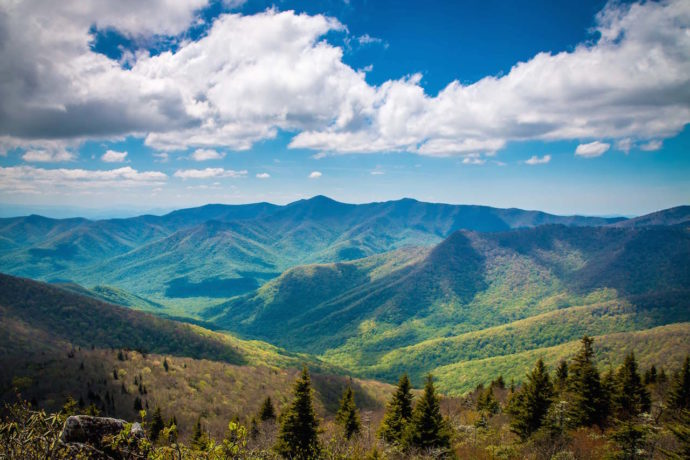
Blue Ridge Mountains Facts Guide
- Geography
- Geology
- History
- Plants of the Blue Ridge Region
- Animals of the Blue Ridge Region
- Folk Arts & Crafts
READ MORE: 20 Incredible Places To See the Blue Ridge Mountains in Fall
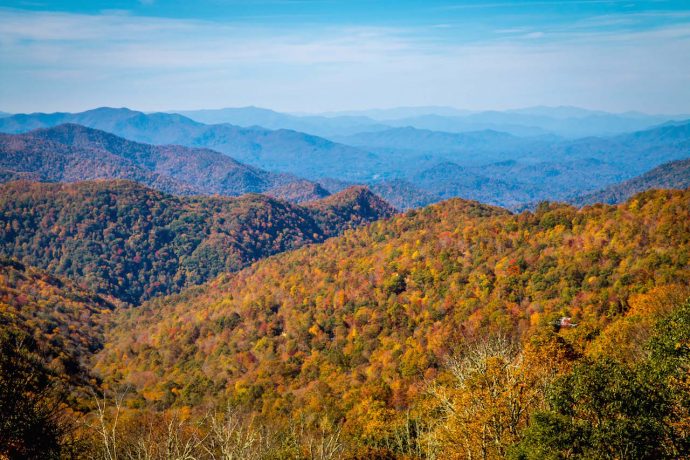
Blue Ridge Mountains Geography
1.The Blue Ridge Mountains are a segment of the Appalachian Mountains, located in the eastern United States. Extending southwest from Pennsylvania, these gorgeous mountains span 615 miles through sections of Maryland, West Virginia, Virginia, North Carolina, South Carolina, Tennessee, and Georgia.
2. The Blue Ridge Mountains encompass a number of smaller mountain ranges, including the Roans, Blacks, Great Balsams, Brushy Mountains, and Great Smoky Mountains. Great Smoky Mountains National Park is the most popular US National Parks, attracting over 11 million visitors each year.
3. This dynamic terrain offers thousands of hiking trails for exploring various sections of the Blue Ridge region, including the famous Appalachian Trail. Starting at Springer Mountain in Georgia and ending at Mount Katahdin in Maine, the 2,175-mile AT passes through many notable spots.
4. With about 125 peaks of 5,000+ feet in elevation, the Blue Ridge is home to the highest mountains in eastern North America. The highest peak in the Blue Ridge range is Mount Mitchell, NC, at 6,684 feet, whose breathtaking views of the region span as far as 85 miles on a clear day!
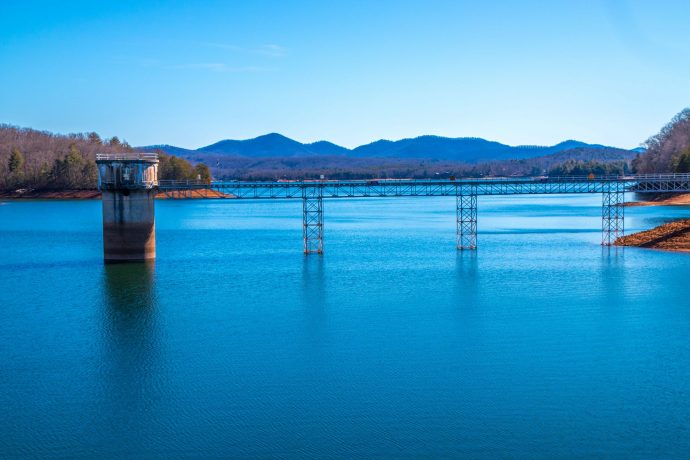
5. The Eastern Continental Divide is an invisible line that follows along the ridgelines of the Blue Ridge Mountains. This line represents where water on each side will flow, separating the Atlantic Seaboard watershed in the east from the Gulf of Mexico watershed in the west.
6. The Blue Ridge Mountains are home to a variety of lakes, rivers, and streams. Some of the most popular include the Ocoee River and the Chattahoochee River (which flows for 400+ miles). One of our favorite places is the stunning 3,290-acre Lake Blue Ridge, which has 65 miles of shoreline.
7. One of the best things to do in the Blue Ridge area is to drive the 469-mile Blue Ridge Parkway, which connects Shenandoah National Park, VA to Great Smoky Mountains National Park, NC. Nicknamed “America’s Favorite Drive” the BRP offers a perfect way to explore the beauty of the region.
8. These mountains are home to a variety of charming mountain towns. Surrounded by towering summits and dense forest, most of the Blue Ridge towns offer a multitude of outdoor activities, restaurants, shopping, and the rich traditions of Appalachian culture.
READ MORE: The Best Things to Do in Blue Ridge, GA
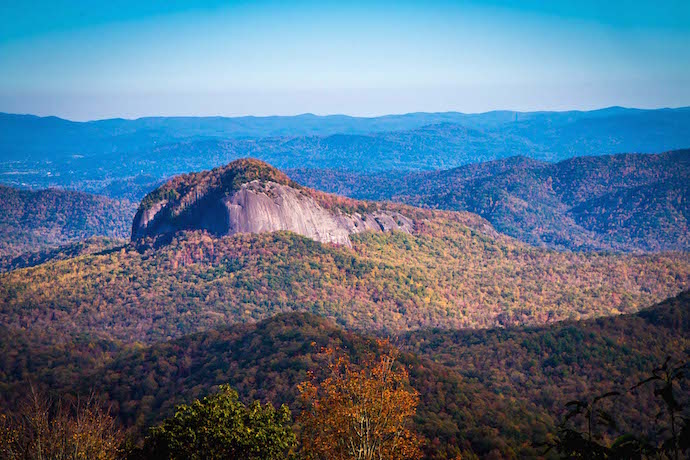
Blue Ridge Geology
9. The Blue Ridge range is estimated to have been created 1.1 billion to 250 million years ago by the uplifting of the Earth’s tectonic plates. This makes the Blue Ridge Mountains the second oldest mountain range in the entire world, after South Africa’s Barberton greenstone belt.
10. These mountains are primarily made of highly deformed metamorphic rocks of Precambrian ages, including schists, slates, quartzites, and gneisses. Recent studies have found that the basement geology of the Blue Ridge is composed of gneisses and granitoids.
11. The Blue Ridge mountains contain some of the richest composition of minerals in the world, including plentiful deposits of micra, feldspar, and quartz (which are used in everyday products like paint and electronics). Amateur miners often visit the Blue Ridge region to mine for gold and gemstones.
READ MORE: The 15 Best North Georgia Mountains for Hiking
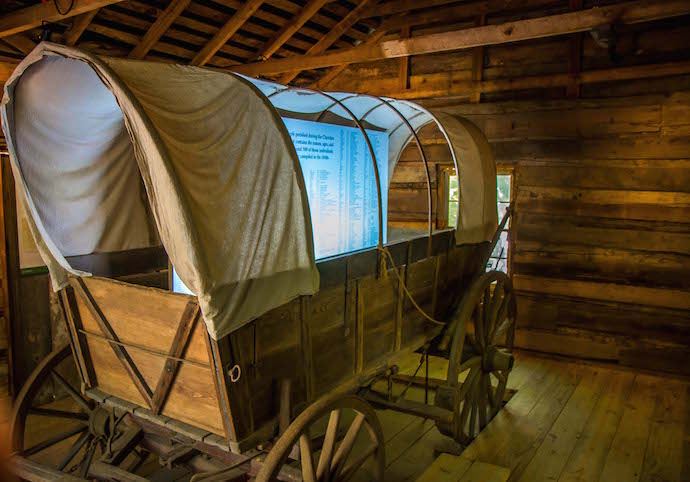
Blue Ridge History
12. Humans first arrived in the Blue Ridge region some 12,000 years ago. The Siouxan Manhouacs, Iroquois, and Shawnee hunted and fished in what is now Virginia’s Blue Ridge, while the Cherokee inhabited much of what is now western North Carolina and North Georgia.
13. During the early and mid-19th century, countless Scots-Irish people immigrated due to famine and persecution. Many settled in North Carolina‘s piedmont region. The folklore, music, crafts, and agricultural practices of their homeland largely shaped the Southern Appalachian culture and history.
14. During the Civil War, Confederate armies used the Blue Ridge mountains as a natural shield. The roads through what is now Shenandoah National Park were regularly used by both armies for travel. General Stonewall Jackson was particularly skilled in using these hidden passes to conceal his troops.
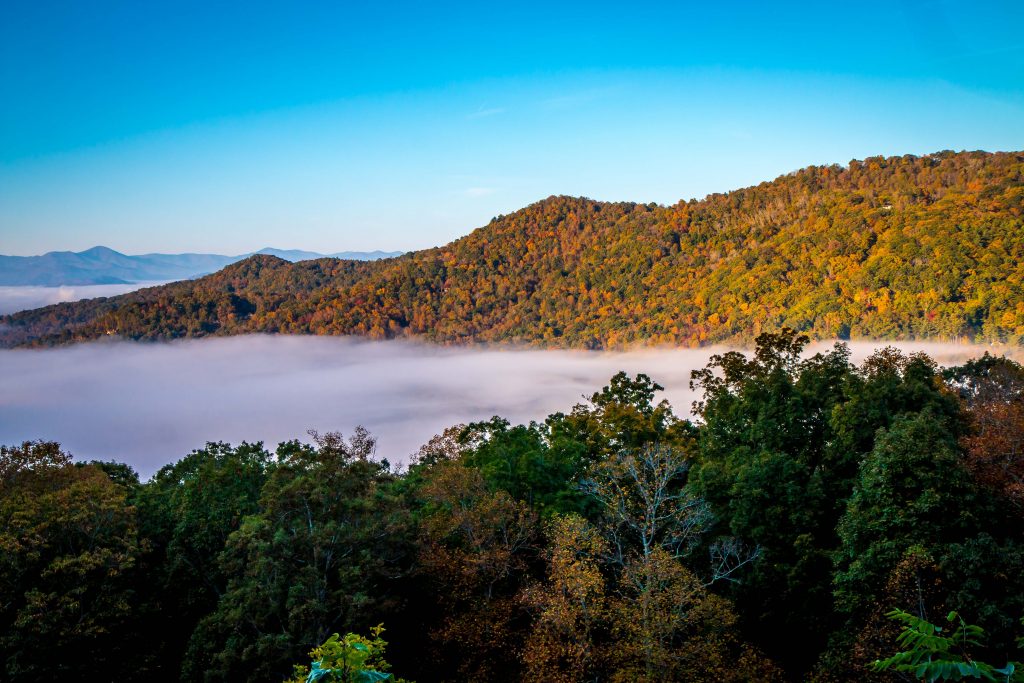
15. Icons like George Washington and Thomas Jefferson regularly visited the Blue Ridge region. Describing the intrigue of the mountains, Jefferson wrote, “It is impossible for the emotions arising from the sublime to be felt beyond what they are here… the rapture of the spectator is really indescribable.”
16. The idea to create the Blue Ridge Parkway came about when President Franklin Roosevelt visited Virginia’s first Civilian Conservation Corps camp as they built Shenandoah’s Skyline Drive. FDR was so impressed, he approved a highway linking Shenandoah and Great Smoky Mountains National Parks.
17. The Blue Ridge Parkway met with controversy over its funding, location, and progress. There were 26 tunnels created through mountain ridges, and dozens of bridges. After starting construction in 1935, the BRP was completed on September 11, 1987– a whopping 52 years after its groundbreaking!
READ MORE: Exploring Craggy Gardens, NC (Blue Ridge Parkway MM 344-384)
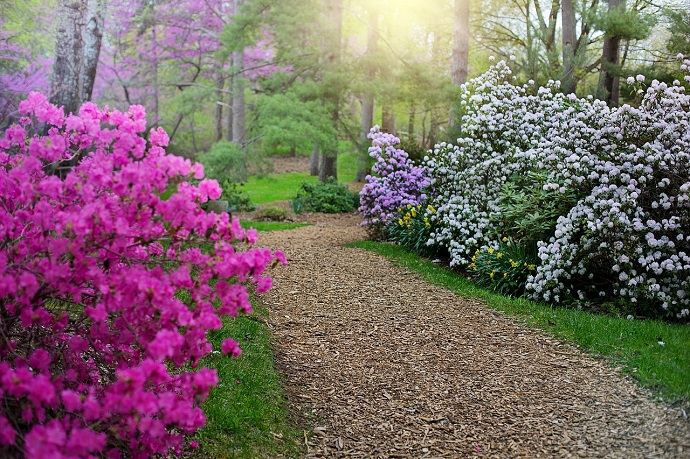
Plants of the Blue Ridge Region
18. The distinctive hue that inspired the mountain range’s name comes from the incredible amount of vegetation in the region. The trees release volatile hydrocarbons such as isoprene, which interacts with other molecules in the atmosphere to create the blue haze that envelopes the Blue Ridge Mountains.
19. The Blue Ridge range is home to a wide variety of trees. Lower elevations offer deciduous forests of oak, sourwood, hickory, maple, yellow birch, yellow buckeye, American beech, and tulip poplar. At elevations above 4,500 feet, evergreens such as Fraser fir, balsam, and red spruce are more abundant.
20. Closer to the ground throughout the Blue Ridge, you’ll see an abundance of flowering shrubs, including rhododendrons that bloom in June with gorgeous white or pink blossoms. Other popular shrubs include flame azaleas, mountain laurel, serviceberry, mountain magnolia, and pinxter flowers.
21. The vast array of beautiful wildflowers that bloom here are truly a sight to see. Of the 1,600 species of vascular plants here, nearly 80% are wildflowers! Some of the most common Blue Ridge flowers are trillium, violet, lady’s slippers, black-eyed Susans, bee balm, bloodroot, spring beauty, and bluets.
READ MORE: The Best Restaurants in Blue Ridge, GA

Animals of the Blue Ridge Region
22. There are many different animals that call the region home, including small mammals like Commensal Rodents, Grey Squirrels, and Chipmunks. You’ll also find larger mammals like Elk, Whitetail Deer, Wild Turkey, and Wild Boar, along with various types of amphibians, reptiles, and invertebrates.
23. Of all the Blue Ridge animals, perhaps the most beloved is the American Black Bear. Great Smoky Mountains NP is the largest protected habitat for Black Bears in the US, with an estimated 1,500 in the park. If you see one, please remember to be cautious and do not approach it for any reason!
24. Birdwatching is a popular Blue Ridge mountains activity, with 250+ bird species found along the Parkway alone! Some of the most common birds of North Carolina are the Cardinal, Common Crow, Carolina Chickadee, Blue Jay, Red-Tailed Hawk, White-Breasted Nuthatch, Song Sparrow, and Tufted Titmouse.
READ MORE: The 15 Best Pisgah National Forest Hiking Trails in North Carolina
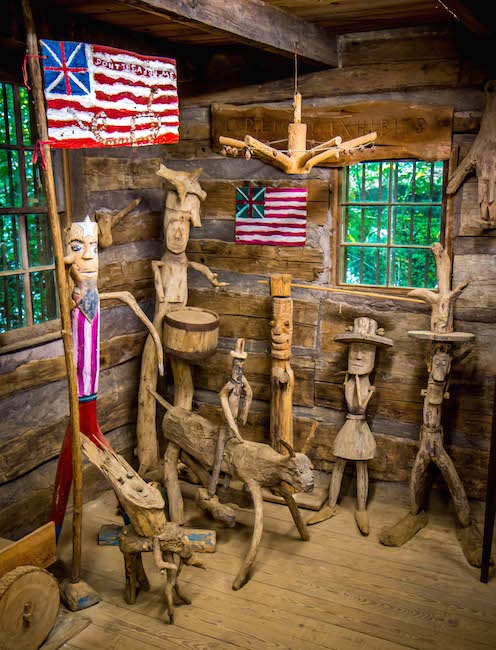
Blue Ridge Folk Arts & Crafts
25. Established in 1895, the Allanstand Craft Shop is the oldest craft shop in the USA. It’s housed in the Folk Art Center on the Blue Ridge Parkway, along with a museum of American Craft, an American Craft library, and three exhibition rooms housing the works of over 300 Appalachian artists.
26. Bluegrass music (a.k.a. “old-time music”) has its roots in post-Civil War Appalachia. It features mostly acoustic instruments and combines traditional Scottish and Irish folk elements. If these catchy tunes have lyrics, they range anywhere from Christian hymns to stories of rural life in the mountains.
27. Woodcarving is extremely popular in the Blue Ridge region. The Cherokee people held woodcarving in high regard, crafting practical items like bowls for cooking as well as masks for ceremonial occasions. Detailed carvings of animal totems, such as Bears and Deer, remain popular today.

28. Quilting is an extremely popular aspect of Scots-Irish Appalachian culture. Excess fabrics from clothes were pieced together for quilts to keep families warm in winter. It was (and is) a communal activity for women: Quilting “bees” were often held in churches, allowing ladies to strengthen their community bonds.
29. Cherokee double-woven baskets are one of the oldest forms of basketry in the Southeast. Baskets crafted from bundled pine needles, river cane, and/or white oak were traditionally used to hold food. Basket weaving is still a prominent craft throughout the Blue Ridge area today.
30. Other crafts connected to the region include blacksmithing, doll making, pottery, and beadwork. The tradition of making these Appalachian crafts by hand has been passed down from generation to generation, and remain a prominent piece of the Blue Ridge mountain heritage. –by Christina Maggitas; photos by Bret Love & Mary Gabbett unless otherwise noted


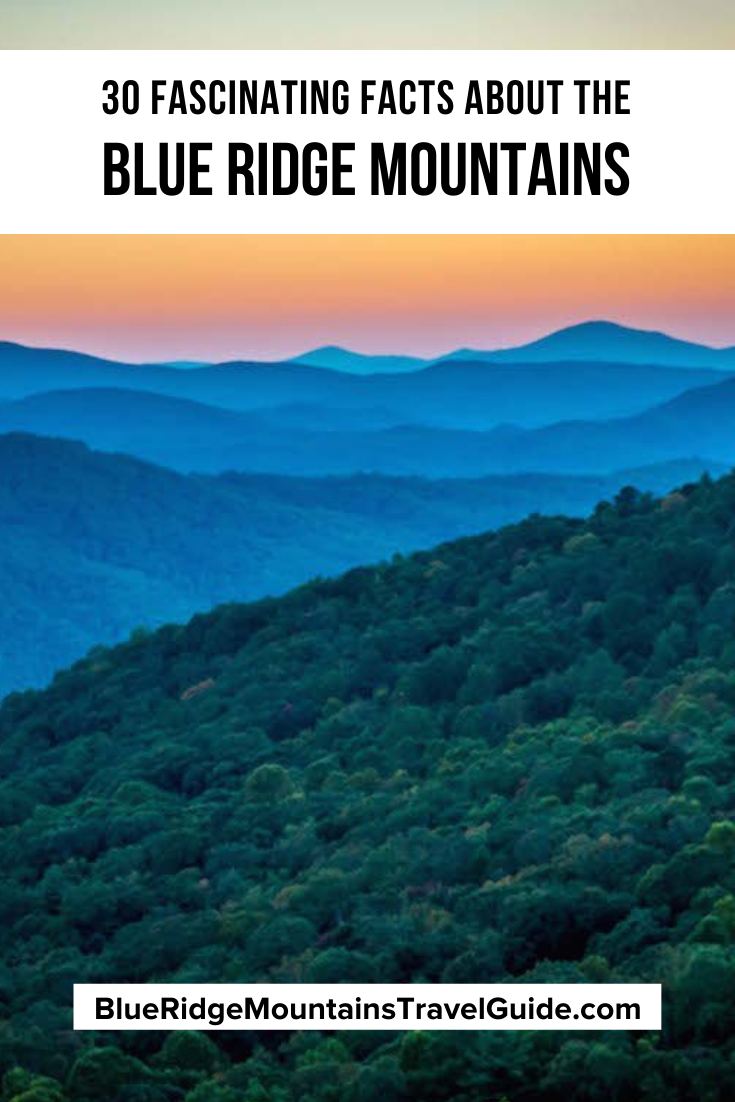
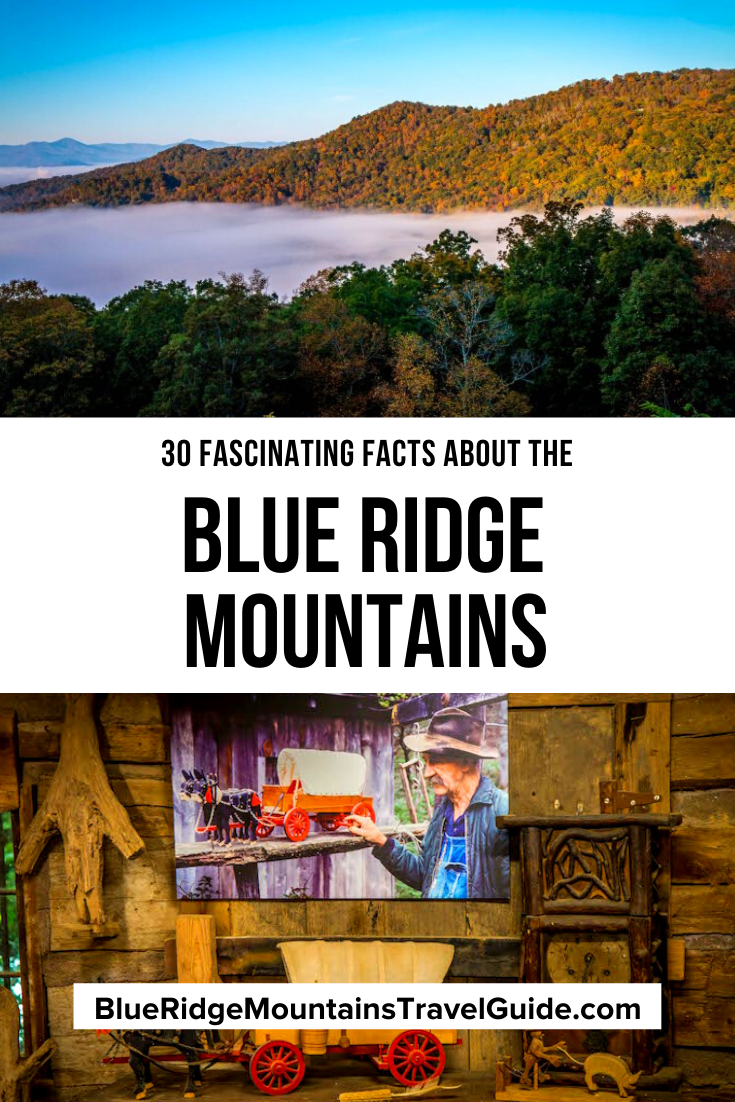

Comments are closed.